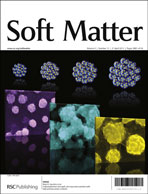A novel family of biodegradable hybrid hydrogels from arginine-based poly(ester amide) and hyaluronic acid precursors
Abstract
A new family of biodegradable and charged hybrid hydrogels was designed and fabricated via photo-crosslinking in an aqueous medium from a hyaluronic acid (HA) precursor and a relatively new amino acid-based poly(ester amide) (AA-PEA) precursor. The HA precursor was synthesized by incorporating an unsaturated moiety (aminoethyl methacrylate, AEMA), while the AA-PEA precursor was synthesized from unsaturated arginine-based poly(ester amide)s (UArg-PEA). These two water soluble precursors were photo-crosslinked to formulate a new family of biodegradable hybrid hydrogels. The chemical structure of these hybrid hydrogels was characterized, and their swelling, mechanical, morphological, biodegradation and drug release properties were examined as a function of the feed ratio of these 2 precursors and the degree of substitution (DS) of AEMA groups in HA-AEMA. The resulting hybrid hydrogels showed a 400–600% swelling ratio, and pH dependent swelling was observed only in a pure HA-AEMA hydrogel. The hybrid hydrogels showed a distinctive sheet-like multi-layered 3D microporous structure confirmed by SEM. Upon trypsin catalyzed biodegradation, the hybrid hydrogels showed 50 to 70% weight loss within 6 days, while the same hybrid hydrogels showed less than 5% weight loss in a PBS medium. The hybrid hydrogels showed a sustained release of bovine serum albumin (BSA) over 25 h, while the pure HA-AEMA hydrogel exhibited a complete release of BSA within 5 h. When compared with a pure HA-AEMA hydrogel, the cationic Arg-PEA/HA-AEMA hybrid hydrogels significantly improved the attachment and proliferation of Hela cells on hydrogel surfaces.


 Please wait while we load your content...
Please wait while we load your content...